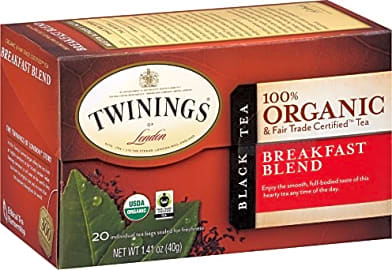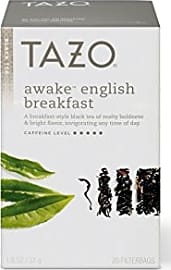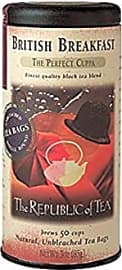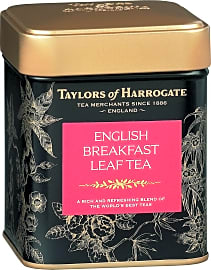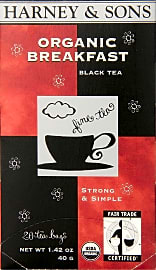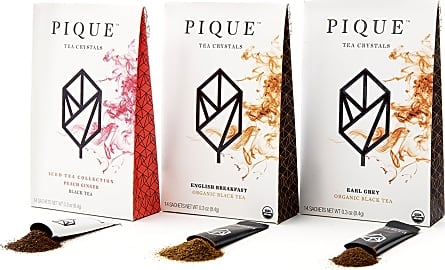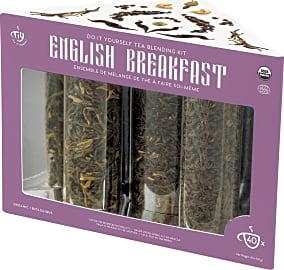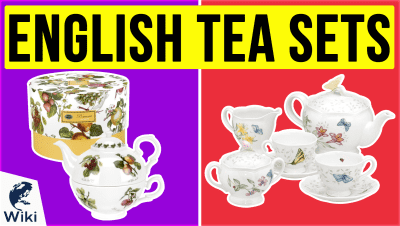The 10 Best English Teas

This wiki has been updated 39 times since it was first published in July of 2015. In the search for a good cuppa, it's a safe bet to turn to the United Kingdom for inspiration. Our carefully curated assortment of English teas runs the gamut from delicately blended aromatic sachets to robust loose-leaf varieties for the serious connoisseur. They are just as suitable for sipping on the veranda as they are for chugging out of a travel mug between meetings. When users buy our independently chosen editorial picks, we may earn commissions to help fund the Wiki.
Editor's Notes
May 03, 2019:
While some folks are content to guzzle old standbys like Lipton and Tetley by the gallon with plenty of ice, others will insist that nothing compares to the pleasure of sipping their favorite single-origin Ceylon, served piping-hot with just the right amount of sugar and milk added. Here, you'll find convenient single-serve packets for enjoyment at a moment's notice wherever drinking water can be found, as well as exotic looseleaf varieties that can be steeped in minutes or left in the fridge to cold-brew over several hours. Alongside familiar offerings from Twinings and Tazo, you'll find the TIY kit for creating personalized blends.
Special Honors
Tee Gschwendner Although Germany might not be the first place you'd think to look for the best English teas, TeeGschwendner's offerings are among the most diverse and tasteful tea selections in Europe. It has a wide variety of black teas and rarefied selections to choose from, like the delightfully brisk Westminster blend of Assam, Java and Ceylon. teegschwendner.de
Tea's Only As Good As You Brew It
The steeping process after that ought to last a good four or five minutes if you want the full flavor of your brew.
It's hard to qualify what it is about tea that is so soothing. There is nothing quite like taking a moment out of our busy day to sit and reflect over a hot cup of tea, no matter how you take it. Even in the warmer months, it serves a purpose, as a glass of iced tea with a little lemon might just be the most refreshing thing on the planet.
In England, tea is almost a religion. Spain has their siestas, the US has "that 2:30pm feeling," and England has tea time. Other cultures have specific rituals around teas, most notably the Japanese tea ceremony, but the British take it one step further by normalizing it among the populous.
That said, recent studies suggest that the Brits aren't particularly adept at making the teas about which they care so much. Perhaps, a little lesson is in order.
After tea leaves are plucked and processed, consumers either pick them up from the store in convenient tea bags or as loose tea, which they have to steep using a variety of available implements. The steeping process allows the dried up leaves to reconstitute themselves through heat and moisture, exchanging flavor and nutrient compounds with the boiling water.
The exact temperature of that water is of vital importance to the quality of your brew, as is the time your tea spends in its bath. For the English teas on our list, you'll want to boil water and let it sit for a moment, that it might cool down to roughly 200˚ F before you pour it over the bag. The steeping process after that ought to last a good four or five minutes if you want the full flavor of your brew. Also, do not add anything like milk or sugar until your brew is complete and you remove the tea from the water.
Taste Your Way To Tea Time
Choosing among teas is, more than most things you could spend time researching online, really a matter of taste. That said, there are certain characteristics you can look for in the description of a given tea that may or may not suit your palate. Additionally, you'll find yourself oscillating between a preference for bagged tea and loose tea on a pretty consistent basis, as both have their merits.
Starting there, most tea enthusiasts will tell you that there is no substitute for loose leaf tea.
Starting there, most tea enthusiasts will tell you that there is no substitute for loose leaf tea. Scientifically, this tends to be true, as loose tea has more room to maneuver in the water, allowing for greater contact and more flavor. What's more, the leaves themselves are larger and less crudely processed than those you'll find in bags, which preserves more of the flavor compounds and more of the nutrients in your tea.
But bagged teas have come a long way, and since most of the teas on our list are bagged, we're going to confine the majority of our comments to comparing and contrasting their qualities. Just make sure you pick a brand that's processed carefully and that you brew it with a modicum of precision.
English teas traditionally have a strong, bold flavor to them, and their characteristics range along the increase in their cost from inexpensive, malty, and dense to lighter, more floral, and more expensive. Despite the differences in flavor, you'll find that the energy-inducing properties of the teas on our list–specifically their caffeine and theophylline counts–are more or less consistent.
A Long Time Brewing
You've got about as good of a chance deducing the origin of tea from scholarly anthropological research as you do from reading it in the tea leaves themselves. The drink, with its origins narrowed down to ancient China, has been with us for so long that its inventor and place of origin are unknown to us.
You've got about as good of a chance deducing the origin of tea from scholarly anthropological research as you do from reading it in the tea leaves themselves.
We do know that its use spread from southwestern China, around the borders with Burma in the Yunnan and Sichuan provinces, sometime around 1500 BCE. Beyond that, we have only legend to account for the first encounter with the brew, and the legends abound.
One such legend states that an emperor sat in relaxation when some leaves blew off a nearby tree and landed in a cup of boiling water. Apparently, at the time, all the country had taken to boiling their water for sanitation. The heat allowed the leaves of this particular tree to expand and fill the cup with flavor.
Another legend centers around the Bodhisattva, the founder of Chan (A.K.A. Zen) Buddhism. This legend states that when the Buddha failed to remain in a meditation that had gone on for nine years, having fallen asleep, he awoke in disgust and cut off his own eyelids. When the Buddha's eyelids fell to the earth, they produced the first tea tree.
Whatever you believe, tea didn't make its way to the west until the 1660s, when King Charles II began importing it from China. The expansion of Great Britain's empire into India and China gave the U.K. unprecedented access to teas cultivated by cheap labor and slave labor, and under these deplorable circumstances, their pleasant afternoon ritual was born.




